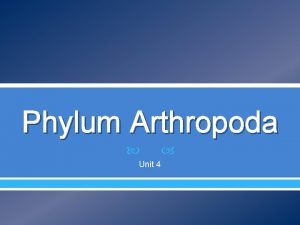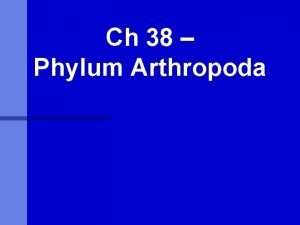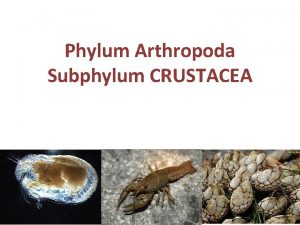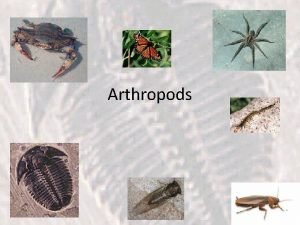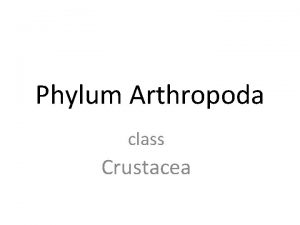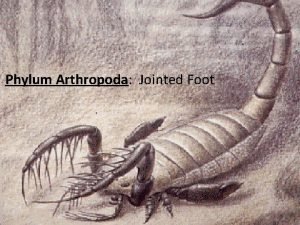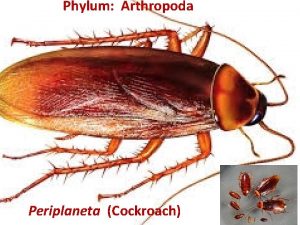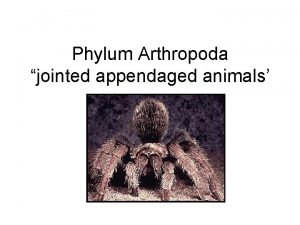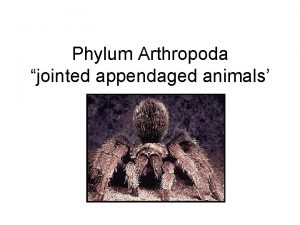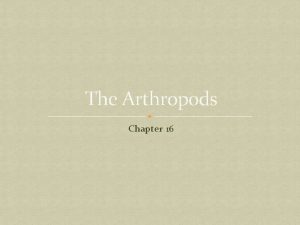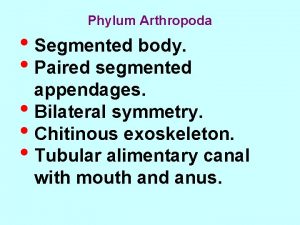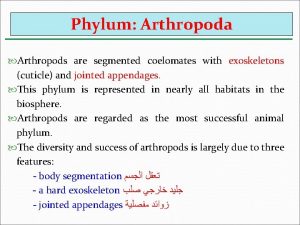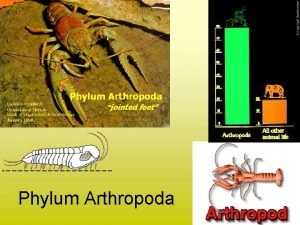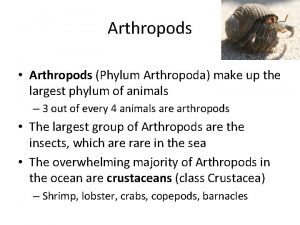Lecture 17 7 Phylum Arthropoda Arthropods are segmented












- Slides: 12

Lecture 17: 7 - Phylum: Arthropoda Arthropods are segmented coelomates with exoskeletons (cuticle) and jointed appendages. This phylum is represented in nearly all habitats in the biosphere. Arthropods are regarded as the most successful animal phylum. The diversity ﺍﻟﺘﻨﻮﻉ and success of arthropods is largely due to three features: - body segmentation ﺗﻌﻘﻞ ﺍﻟﺠﺴﻢ - a hard exoskeleton ﺟﻠﻴﺪ ﺧﺎﺭﺟﻲ ﺻﻠﺐ - and jointed appendages ﺯﻭﺍﺋﺪ ﻣﻔﺼﻠﻴﺔ

The body of an arthropod is completely covered by the cuticle, an exoskeleton constructed from layers of protein and chitin. The exoskeleton of arthropods is strong and relatively impermeable to water. Arthropods have well-developed sense organs, including eyes for vision, olfactory receptors for smell, and antennae for touch and smell. Have sensory antennae ﻗﺮﻭﻥ ﺍﺳﺘﺸﻌﺎﺭ and usually a pair of compound eyes in addition to simple eyes. Arthropods have an open circulatory system in which hemolymph fluid is propelled by a heart through short arteries. Arthropods have evolved a variety of specialized organs for gas exchange.


1 - Class: Arachnida ﻃﺎﺋﻔﺔ ﺍﻟﻌﻨﻜﺒﻴﺎﺕ These include scorpions ﺍﻟﻌﻘﺎﺭﺏ , spiders ﺍﻟﻌﻨﺎﻛﺐ , ticks ﺍﻟﻘﺮﺍﺩ , and mites ﺍﻟﺤﻠﻢ. They have four pairs of walking legs. Nearly all ticks are blood-sucking ﻣﺎﺹ ﻟﻠﺪﻣﺎﺀ parasites on the body surfaces of most animals. In most spiders, respiration ﺍﻟﺘﻨﻔﺲ is carried out by book lungs ﺍﻟﺮﺋﺔ ﺍﻟﻜﺘﺎﺑﻴﺔ.

2 -class: Insecta ﻃﺎﺋﻔﺔ ﺍﻟﺤﺸﺮﺍﺕ They live in almost every terrestrial habitat and in fresh water, and flying insects fill the air. The study of insect, (Entomology) is a vast field with many subspecialties, including physiology, ecology, and taxonomy…. etc. Class Insecta is divided into about 26 orders. • Many • insects have one or two pairs of wings that emerge from the dorsal side of the thorax. They have three pairs of legs.

The Insects: 750, 000 + species insects described, but may be 30 million species undescribed. Many adaptations make insects one of the most successful terrestrial animals. o Exoskeleton for water conservation. o Tracheal System for gas exchange. o Metamorphosis. o Many types of mouth parts. o Flight.

In the complete digestive system, there are regionally specialized organs. Metabolic wastes are removed from the hemolymph ﺍﻟﺪﻡ by Malpighian tubules ﺃﻨﺎﺑﻴﺐ ﻣﻠﺒﻴﺠﻲ , out pockets of the digestive tract. Respiration is accomplished by a branched, chitin-lined tracheal system ﺍﻟﺠﻬﺎﺯ ﺍﻟﻘﺼﺒﻲ that carries O 2 from the spiracles directly to the cells. The insect nervous system consists of a pair of ventral nerve cords ﺣﺒﻠﻴﻦ ﻋﺼﺒﻴﻴﻦ ﺑﻄﻨﻴﻴﻦ with several segmental ganglia.


3 Kinds of Insect Metamorphosis Ametabolous Metamorphosis: only difference between larvae and adult are size; both are wingless. Hemimetabolous (Incomplete) Metamorphosis: develop from egg to adult has several stages with smaller versions of adults called nymphs. Immature nymphs have no wings or genitalia until adult. Holometabolous (complete) Metamorphosis: after hatching from egg, immatures are called larvae (very different body form than adult). After several instars, the last larval molt forms a pupa – undergoes radical body form change.

Incomplete or Hemimetabolous Metamorphosis

Complete or Holometabolous Metamorphosis

You Decide?


